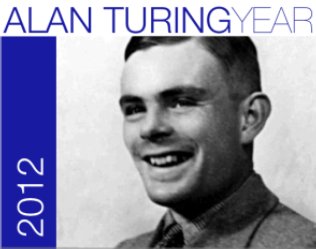

|
| Tutorial Teaching Assistants: Alexander Cooper, Spyridon Dimoudis, Alexander Levine |
|
| Times |
Who |
| Tuesdays, 16.20 to 17.10 Rooms JN301,
JN302 |
All CS students |
| Wednesdays, 11.20 to 12.10 Room CMS01 |
All Maths students |
A. Doxiadis, C. H. Papadimitriou, Logicomix, Bloomsbury, 2009. This is a graphic novel about the early development of logic.
D. Harel, Computers Ltd What they really can't do, OUP, 2012.
D. R. Hofstadter, G"odel, Escher, Bach: an eternal golden braid, Basic Books, 1999. Mind blowing.
D. Cryan, S. Shatil, B. Mayblin, Introductory logic: a graphic guide, Icon Books, 2008. Student recommendation.Some of the people involved in the development of logic:
The following are textbooks rather than reading books:Ray Monk, Biography of Bertrand Russell: 1872-1920 Volume 1, Vintage, 1997.
Ray Monk, Ludwig Wittgenstein: the duty of genius, Vintage, 1991.
Andrew Hodges, Alan Turing: the enigma, Vintage, 2014.
Richard Tieszen, Simply Goedel, Simply Charly, 2017.
Desmond MacHale, The life and work of George Boole, Cork University Press, 2014.
R. Hammack, Book of proof, VCU Mathematics Textbook Series, 2009. This book can be downloaded for free here.
M. V. Lawson, A first course in logic, CRC Press, 2019.
A PDF of a prepublication version of this book will be made freely available via VISION to all students registered for this course.
The book covers much more than the lecture course. The errata page for this book can be found here.
S. Lipschutz, M. Lipson, Discrete mathematics, second edition, McGraw-Hill, 1997. This is useful for further practice in the mathematical ideas introduced in this course.
P. Teller, A modern formal logic primer, Prentice Hall, 1989. This is now freely available. Just click the title. This is a more sophisticated book than Zegarelli (i.e. no cartoons)
but is still at the same level as this course. It is highly recommended.
M. Zegarelli, Logic for dummies, Wiley Publishing, 2007
Propositional logic. Chapters 1 to 14 inclusive. Things really get going in Chapter 4. Chapter 8 is on truth-trees. You can omit Chapters 9 to 12 inclusive
because I don't do proofs in this course. At the end of Chapter 14 is an introduction to Boolean algebras.
Predicate logic. Chapters 15 to 19 inclusive deal with predicate or first-order logic.
Background reading. Chapters 20 to 25 inclusive.
| Tuesday 13.20 |
Wednesday 13.20 |
Friday 12.20 |
Homework |
|
| Week 1 16 Sept to 20 Sept |
CHAPTER 1 Introduction to course |
Lecture 2 |
Lecture 3 |
You
should do the Introductory Exercises in the book. They do not need any special background to attempt. Solutions at the back of the book. Do Exercises 1.1. |
| Week 2 23 Sept to 27 Sept |
Lecture 4 |
Lecture 5 |
Lecture 6 Revision of lectures 1 to 5. |
Do Exercises
1.2, Question 1 ONLY. Do Exercises 1.3. |
| Week 3 30 Sept to 4 Oct |
Lecture 7 |
Lecture 8 |
Lecture 9 |
Do Exercises
1.4. Do Exercises 1.5, Question 1 only. |
| Week 4 7 Oct to 11 Oct |
Lecture 10 |
Lecture 11 |
TEST 1 DURING LECTURE Lectures 1 to 6 inclusive only Test lasts 15 minutes You can stay as long as you like after that to complete it |
Exercises
1.6. Exercises 1.7. Question 1 only. |
| Week 5 14 Oct to 18 Oct |
Lecture 12 Revision of lectures 1 to 11. |
Lecture 13 |
Lecture 14 |
Exercises
1.8. |
| Week 6 21 Oct to 25 Oct |
Lecture 15 |
Lecture 16 |
Lecture 17 |
Exercises
1.9. Exercises 1.10 Questions 1 and 2. You can do Question 3 if you want but it is not essential. |
| Week 7 28 Oct to 1 Nov |
Lecture 18 |
Lecture 19 |
Lecture 20 Revision: Question 2 of last year's exam paper. |
Exercises
1.11. THIS CONCLUDES CHAPTER 1 |
| Week 8 4 Nov to 8 Nov |
CHAPTER
2 Lecture 21 |
Lecture 22 |
TEST 2 DURING LECTURE Lectures 7 to 16 inclusive (and assuming lectures 1 to 6 inclusive) Test lasts 15 minutes You can stay as long as you like after that to complete it |
Exercises
1.2 Questions 2 and 3. Exercises 2.1. |
| Week 9 11 Nov to 15 Nov |
Lecture 23 |
Lecture 24 |
Lecture 25 |
Exercises
2.2. Exercises 2.3. THIS CONCLUDES CHAPTER 2 |
| Week 10 18 Nov to 22 Nov |
CHAPTER 3 Lecture 26 |
Lecture 27 |
Lecture 28 |
Exercises
3.1. Exercises 3.2. |
| Week
11 25 Nov to 29 Nov |
Lecture 29 THIS CONCLUDES CHAPTER 3 |
Lectures are concluded |
|
Calculators are neither required nor allowed in this course
In mathematics, we provide only one past exam paper and its solutions.
This is so that you will have an idea of the format of the exam paper.
To prepare for the exam, you should work through all the exercises referring to the lecture notes as and when needed.
